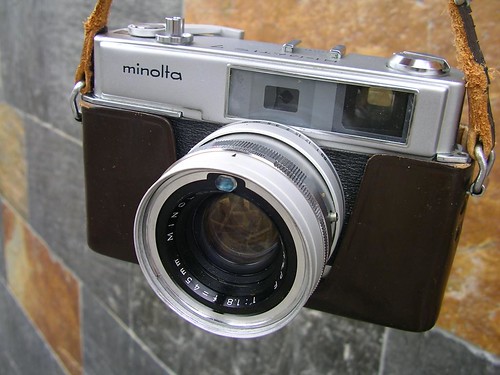Minolta Hi-Matic 7

|
| image by Uwe Kulick (Image rights) |
In 1963 the Minolta HI-MATIC 7 succeeded the original Minolta Hi-Matic 35mm rangefinder camera. It had new features, especially a CdS meter placed above the lens optics within the filter ring, a manual shutter speed selection mode, and the exposure meter's actual EV-value displayed in the viewfinder. Like the original Hi-Matic its viewfinder was a rangefinder with mechanical parallax correction, and it had a self-timer. With this camera Minolta made the "Hi-Matic" camera series their main series of range- and viewfinder cameras. Every Hi-Matic had auto-exposure, and increasing support for flash use.
The Hi-Matic 7s and Hi-Matic 9 followed in 1966, and were improved versions of the 7. The 7s came with the Contrast Light Compensator (CLC) metering system, which offered improved metering, especially in high contrast situations. Also the 7s added a hot shoe and Safe Load System (SLS) indicator to show that film was being transported properly. The range finder windows changed from a contrasting 'pink and green' tint to 'yellow and blue'. The carrying strap lugs were moved up to the side and given a more rounded shape. The end of the lens barrel is black rather than the brushed aluminium of the 7. The 9 was the same as the 7s with the addition of a slightly faster f/1.7 lens, and an easy flash system, where the flash guide number was dialled into the lens, and the aperture was set automatically, according to the focus distance.
The Hi-Matic 7s appears to have remained in production until the introduction of the 7s II in 1977.
- Type: rangefinder camera
- Manufaturer: Minolta
- Year of release: 1963
- Films: 35mm films with speeds 25 to 800 ASA
- Lens: 6 lenses 1:1,8 f=45mm Rokkor
- Metering: CdS meter, EV 5.7 - EV 17
- Weight: 770 g
- Dimensions: 140×82×73mm
Pictures

|

|

|

|

|
|
Pictures of the Minolta Hi-Matic 7s with added hotshoe and CLC metering | ||||
Links
- Minolta Hi-Matic page in wikipedia
- Hi-Matic 7, Hi-Matic 7s, Hi-Matic 7s II on www.collection-appareils.fr by Sylvain Halgand
- Hi-Matic 7 in Minowiki [1]
- Minolta Hi-Matic 7s at My 35mm Film Camera Collection